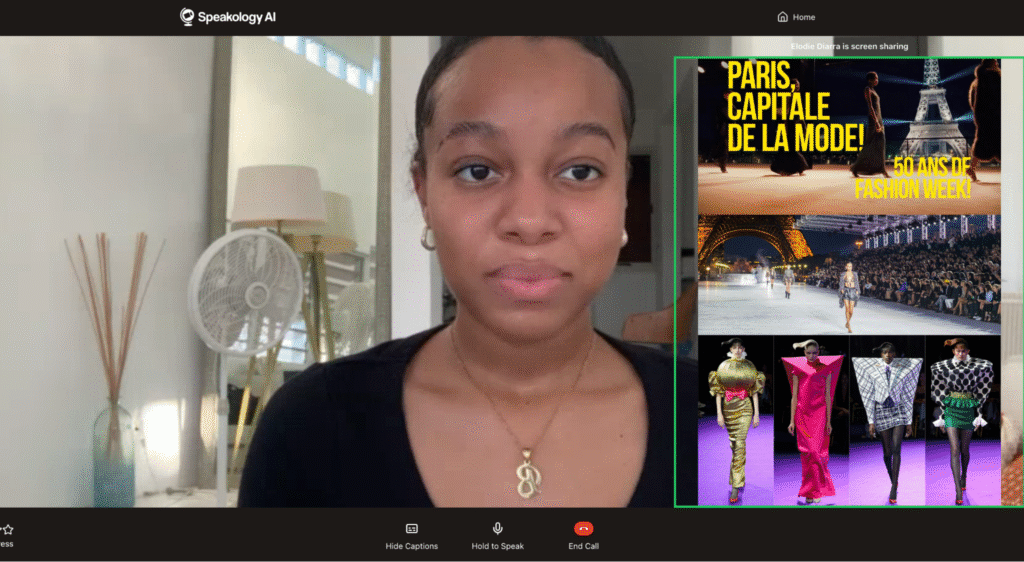
Speakology AI: The Future of Conversational Speaking Practice is Here
By Lauren Rosen, Universities of Wisconsin

DOI: https://www.doi.org/10.69732/SNXT5205
Have you ever wished students could overcome speaking anxiety, engage in more personalized conversations with native-like tutors, and practice using the vocabulary and structures they truly need? Well, that time is now, and Speakology AI offers a solution far more dynamic than a generic AI chatbot.

Speakology AI’s tutors are advanced AI technology, presented as human-like avatars, programmed to align with an educator’s specific course content. The educator provides the company with information such as course themes, textbook table of contents, proficiency targets, can-do statements, and whatever else they feel would be most helpful for the AI instructor to know. The team at Speakology AI programs the avatars to work with the structures and language of a specific course, and students have 24/7 access to practice speaking as often as they want. The educator sets the level of feedback students receive so the avatar coaches students during their conversations. Additional images and other media can be provided for specific speaking activities to serve as informational prompts that students use during these conversations. This media provides more context, helping to activate student background knowledge and creativity. While only a small amount of preliminary data from 38 students of Chinese, French, German, Japanese, and Spanish during a Spring 2024 pilot has been collected, we do have self-reported evidence that students using Speakology AI are feeling more confident and prepared for real world interactions. Additionally, students in classes that used Speakology appear to be performing higher on speaking using the Avant STAMP 4S assessment than in previous years without Speakology AI.
|
Tool |
SpeakologyAI |
|
URL |
|
|
Purpose |
Interpersonal speaking practice with a human-like avatar instructor |
|
Cost |
Institutional pricing is approximately $23/student/per semester with the rate decreasing with a larger number of students. Includes LMS integration, course alignment and priority support. Individual pricing is $25/month or $120/year. |
|
Ease of use |
Super easy to get started. The instructor provides an access code for students to enter the course. The experience resembles having a video call with a friend. The student video is not recorded, eliminating any privacy concerns. FERPA, COPPA, GDPR, CCPA/CPRA/SOPPA compliant. |
|
Languages Supported |
The list of languages is growing with demand from users. Currently the site identifies the following languages while encouraging requests for more: Arabic, Chinese (Mandarin), Croatian, English, French, German, Hebrew, Indonesian, Italian, Japanese, Latin, Portuguese (Brazil), Portuguese (Europe), Russian, Spanish, Swedish, Swiss German, Turkish, Thai, and Vietnamese. |
How to Get Started and What to Expect
First, expect to work with a company that is keen to learn your needs as an educator and responsive to questions and concerns. Everyone I have spoken to and worked with is genuinely interested in shaping their product to meet the needs of today’s instructional environment and student success targets.
Accessing Speakology AI begins by visiting their website, where you can explore features tailored for educators or individual learners (those learning a language on their own or supporting FILL programs with individual learners).
If you are working at an institution that uses Canvas, Google Classroom, or Blackboard, integration with learning management systems is available for a seamless student experience. As a course instructor, your first step is to provide Speakology AI with course content to build your course and train the avatar tutor. They then design a course specific to your content. Then you add required speaking practice exercises into your syllabus. Your students enter either through their learning management system or a code you provide. Once they sign in, they see their course broken into chapters based on the themes you teach. Within each chapter is a series of lessons to be assigned. There are currently 5 very realistic avatars for students to choose from, including one that is in phone call mode if a student prefers to not see a human-like avatar. This choice can be switched for each lesson or a student can stick with the one they prefer. More avatars are being built, so look for additional options coming soon. According to the students surveyed, Speakology AI “gives you the illusion you are speaking with someone real” while students also appreciated the opportunity to practice in a completely non-judgmental environment. Lowering student stress levels through building speaking confidence is essential for language learners, and often speaking to a computer is less intimidating than a real person.
Speakology AI is more than just a speaking tutor trained on your content for guided conversations. Instructors can also create assignments, oral exams, and quizzes. Students receive instant feedback on grammar and pronunciation, along with a full report of what was practiced and learned.

The course instructor can track student progress throughout the semester with options to click on a single student and see their scores for each topic across the semester. By digging into a specific assignment in a submission assessment such as the one pictured above, the report references both ACTFL and CEFR levels and seems to be quite accurate. I tested with my far from perfect German and it matched my Avant STAMP score. This helps students know how they are progressing on their path to proficiency. The feedback also provides students clear explanations of what assistance they requested and the key structures and vocabulary used in their conversation.
Course and Assignment Settings
Speakology AI offers instructors the option to create their own courses and assignments in addition to those custom built by Speakology AI.
In instructor-developed courses, the educator titles the course, assigns the language, and chooses the proficiency target. Then they choose a course structure such as AAPPL topics, AP language and culture, one of the first 4 year options, or a flexible template for all learner levels. In the case of some of their newer languages, these structures are still in development. Speakology AI then provides some tips to get started and your course is generated automatically with assignments filled in.
Creating assignments to add to existing courses is easy. Simply enter the <Teaching> settings from the top right of the screen and from there assignments, conversations, writing exercises, and quizzes can be added. Once in these areas prompts guide the educator in the development of activities that require the AI tutor to ask specific questions or guide the conversation that students engage in with the avatar. In all cases the educator identifies the target proficiency level so the student is assessed against that expected target.
In setting up a speaking assignment, in addition to providing some of the conversation content information, the AI avatar can share an image for context, correct the student in the native or target language, and follow the instructions of the educator about how explicit the feedback given to the student should be. Some other settings include ACTFL level, example vocabulary and questions, and whether the AI or the student should be the one leading the conversation.
In addition to the speaking activities, a writing component has been added. The student must type into the space provided and is blocked from pasting anything into the space. A pop-up warns that the instructor will receive a message letting them know that the students tried to paste content into the box. The AI feedback provided was quite accurate and it caught errors and gave explanations for changes. The instructor is able to see all the feedback and the original essay in the gradebook.
The quizzing feature is speaking-focused only. In this kind of assignment, the Avatar asks only the questions provided by the instructor. Currently there is not an option to upload an image to support the context of the prompt, and there are minimal settings for this feature, but it may continue to be developed in the future.
Practical Uses
Speakology AI is currently being used by instructors in the UW Collaborative Language Program as assignments to support distance learning courses and a few other UW traditionally taught courses in Chinese, French, German, Japanese, and Spanish ranging from Novice (2nd semester) to Intermediate High (6th semester). While students have fewer synchronous meetings with their instructors in the distance learning courses, they are expected to reach the equivalent proficiency targets to those in the same level of a traditionally taught course. In some courses there were specific required assignments with the AI platform, while in others it was optional.
In surveys of their experiences students commented on feeling less pressure talking to an AI and that the conversations felt realistic with appropriate follow up questions. The majority of the 38 survey respondents indicated having a positive experience, however there were some who thought it felt awkward and took some getting used to between the first and fourth interactions. Overall the opportunity for low stakes speaking practice seemed to outweigh the number of respondents at the beginning of use that indicated it felt silly or unnatural. By the end of the semester 80% of students indicated a medium to high level of comfort with the tool; an increase of 30% from the first assignment to the last. The reality is that students who chose to do the assigned Speakology AI activities and/or extra speaking practice on their own outperformed students who either chose not to participate in these activities or who did not have this tool available to them.
We did find that some of our neurodivergent students struggled with looking at the avatar and the background. Once this was reported to the company they created the “phone call” solution previously mentioned in this article. This removes any awkwardness in the visual for students who are able to choose the AI avatar with which they will converse.
Conclusion
Whether courses are taught in a distance environment or in a more traditional learning setting, Speakology AI supports individualization, differentiation, and increases the amount of time students actually speak in the target language. Speakology AI’s one-on-one conversation partner approach, where students control when and how long they speak, also provides personalized assistance with words and phrases students want to use, and the AI avatar supports the student at their level. No two conversations are the same, nor are they rehearsed and practiced. This spontaneity with a life-like avatar and the ability to practice speaking for as many minutes as a student chooses at their convenience sets Speakology AI apart from all other available technologies.
The more students practice, the more fluid their speech becomes, and their vocabulary and accuracy grow through implementing the feedback provided. The ultimate goal is for students to be equipped to speak to real people in real time, spontaneously. This is also the hardest skill for students to master. While many tools aim to be all-encompassing, Speakology AI excels by focusing on a unique strength: providing true conversational speaking opportunities. As Speakology AI explores new areas like writing, my hope is they continue to prioritize this core strength—lowering the affective filter and preparing students for spontaneous, real-life conversations —a feature few others have truly mastered.

Excellent article about a very interesting tool for giving language learners a chance to improve their speaking skills! Thank you very much for the explanation of how it works and can be used with different types of students in both distance and local learning situations.
The high cost of the tool gives great pause–especially for university students–and having more specifics of how it was used in the classes and what specific benefits the learners reported to justify the cost would have been helpful.
The tool does looks really beneficial and has a lot of potential for providing individualized language practice. Thank you very much for sharing this article with us!